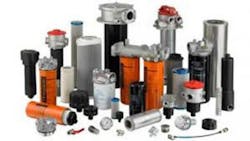How To Buy Hydraulic Filter Elements - The Right Way
One of our readers wrote me this question:
"We are evaluating filters for a contract and I had the suppliers give me the Beta ratios for the elements they propose to supply. The problem is one company has given me Beta ratios for 2 and 11 microns, and the other company, 6 and 20 microns, i.e.:
Company A's filter is Beta2 = 2 and Beta11 = 20
Company B's filter is Beta6 = 2 and Beta20 = 75
So the way I read it:
Company A's filter is 50% efficient at 2 micron and up and 95% efficient at 11 micron and up. Company B's is 50% efficient at 6 micron and up and 98.7% efficient at 20 micron and up.
My question is which filter is better?"
Certainly, the different blocking sizes on which the Beta ratios are stated above, makes an 'apples to apples' comparison extremely difficult (for detailed explanation of filter Beta ratios and efficiency, read chapters 8 and 9 of The Hydraulic Maintenance Handbook).
But the short answer to this question is: the better filter is the one that will achieve and maintain the required or targeted fluid cleanliness level (at the lowest cost). Which by extension means, it's possible that neither of the above filters are suitable for the application.
The reason I say this is because both the above filters have relatively poor Beta ratios by today's hydraulic filtration standards. For comparison, a Hydac (the first catalogue I pulled off my shelf) BN3HC 10-micron element is rated: Beta10 = 500 and Beta5 = 100!
And unless you have a very old, non-critical, low-pressure hydraulic machine, in this day and age, you should have a filter rated Beta10 =/>100 installed at least somewhere in the system. This level of filtration can be expected to achieve a fluid cleanliness level (ISO 4406:1999) of around 19/17/14, which is pretty decent but not super clean.
Keep in mind though, it is unwise to upgrade existing filter housings with finer, more efficient elements, without first checking that the increase in pressure drop created by the new filter-element is not going to cause problems. Like putting the filter on bypass, for example.
As with most maintenance issues, the best approach is to start with the end in mind. In this case it means:
1. Establishing the required or targeted fluid cleanliness level for the machine or system;
2. Specifying a minimum, filter-element blocking size and Beta ratio that can be realistically expected to achieve the desired cleanliness level;
3. If this involves an upgrade of the elements in existing filters housings, flow rates and pressure drops must be checked to confirm the higher filter specification won't cause any problems.
4. And then the filter supply contract can be released for commercial tender.
In other words, sourcing filters or any other hydraulic consumable without doing your homework first can be a costly mistake. And to discover six other costly mistakes you want to be sure to avoid with your hydraulic equipment, get "Six Costly Mistakes Most Hydraulics Users Make... And How You Can Avoid Them!" available for FREE download here.
About the Author
Brendan Casey Blog
Author
Brendan Casey is a war-weary and battle-scarred veteran of the hydraulics industry. He's the author of The Hydraulic Troubleshooting Handbook, Insider Secrets to Hydraulics, Preventing Hydraulic Failures, The Definitive Guide to Hydraulic Troubleshooting, The Hydraulic Breakdown Prevention Blueprint and co-author of Hydraulics Made Easy and Advanced Hydraulic Control. And when he's not writing about hydraulics or teaching it, Brendan is flat-out helping consulting clients from a diverse range of industries solve their hydraulic problems. To contact him visit his company's Website:
www.HydraulicSupermarket.com

Leaders relevant to this article:
